#Remote Employee Time Tracking
Explore tagged Tumblr posts
Text
Time Flies: Managing Remote Employee Time Tracking Challenges
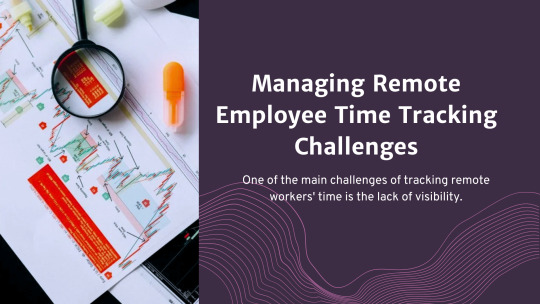
Time and productivity tracking for remote workers has become a critical task for businesses. With the rise of telecommuting, companies face new challenges in ensuring that their remote workforce remains productive and accountable. In this article, we'll explore the challenges of remote employee time tracking and how to effectively manage them.
Challenges of Tracking Remote Workers
One of the main challenges of tracking remote workers' time is the lack of visibility. Unlike in a traditional office setting, where managers can physically see employees working, remote work makes it difficult to monitor employees' activities. Concerns over accountability and productivity may arise from this lack of visibility.
Another challenge is the potential for distractions. Working from home can blur the lines between work and personal life, making it easy for employees to become distracted by household chores, family members, or personal activities. These distractions can impact productivity and make it harder to track time accurately.
Effective Time Tracking for Remote Employees
To effectively track the time of remote employees, businesses can use various tools and strategies. One popular method is to use time tracking software specifically designed for remote work. These tools allow employees to log their hours worked and track their productivity, providing managers with real-time visibility into their team's activities.
Another strategy is to establish clear expectations and guidelines for remote employees. It includes setting specific work hours, outlining tasks and deadlines, and communicating regularly with team members. By setting clear expectations, employees are more likely to stay focused and productive.
Remote Worker Time Tracker Software
Remote worker time tracker software can help businesses overcome the challenges of tracking remote employees' time. These tools offer features such as automatic time tracking, task management, and productivity monitoring. Managers can use these tools to track how much time employees spend on different tasks, identify potential bottlenecks, and make informed decisions to improve efficiency.
Remote Workforce Management Software

In addition to time-tracking software, businesses can use remote workforce management software to streamline their remote work processes. These tools offer features such as inside threat prevention, employee scheduling, performance monitoring, and collaboration tools. By using these tools, businesses can ensure that their remote workforce remains productive and accountable.
Maintaining Communication and Trust
One of the key aspects of effective time tracking for remote employees is maintaining open communication and building trust. Managers should regularly check in with remote employees to discuss their progress, address any concerns, and provide feedback. It helps build a sense of accountability and ensures that employees feel supported in their work.
Another significant factor is trust. Trusting remote employees to manage their time effectively is crucial for maintaining a positive work environment. By demonstrating trust in their employees, managers can foster a sense of responsibility and encourage employees to take ownership of their work.
Implementing Flexible Work Policies
To further support remote employees, businesses can implement flexible work policies. These policies allow employees to work at times that are most convenient for them, which can help improve work-life balance and reduce stress. Flexible work policies can also help employees manage their time more effectively, leading to increased productivity.
Utilizing Performance Metrics
In addition to time tracking, businesses can use performance metrics to evaluate the effectiveness of their remote workforce. Metrics such as project completion rates, customer satisfaction scores, and employee feedback can provide valuable insights into the performance of remote employees. By analyzing these metrics, businesses can identify areas for improvement and make data-driven decisions to enhance productivity.
Encouraging Work-Life Balance

Promoting work-life balance is essential for remote employees to avoid burnout and maintain productivity. Encourage employees to establish boundaries between work and personal life by setting specific work hours and taking regular breaks. Providing resources for mental health support can also help employees manage stress and stay motivated.
Training and Development Opportunities
Investing in training and development opportunities for remote employees can improve their skills and productivity with keystroke logging. Offer online courses, workshops, and seminars that are relevant to their roles and career goals. By investing in their professional development, employees are more likely to stay engaged and committed to their work.
Regular Performance Reviews
Conducting regular performance reviews is crucial for tracking remote employees' progress and providing constructive feedback. Use these reviews to discuss goals, address any performance issues, and recognize achievements. It helps employees stay motivated and ensures that they are meeting expectations.
Conclusion
Managing remote employee time tracking challenges requires a combination of effective tools and strategies. By using time-tracking software, setting clear expectations, and utilizing remote workforce management software, businesses can overcome the challenges of tracking remote employees' time and ensure that their remote workforce remains productive and accountable.
#Remote employee time tracking#Tracking remote workers#Remote workers time tracking#time Tracking for remote workers#Time tracking for remote employees
0 notes
Text
Time Flies: Managing Remote Employee Time Tracking Challenges

Time and productivity tracking for remote workers has become a critical task for businesses. With the rise of telecommuting, companies face new challenges in ensuring that their remote workforce remains productive and accountable. In this article, we'll explore the challenges of remote employee time tracking and how to effectively manage them.
Challenges of Tracking Remote Workers
One of the main challenges of tracking remote workers' time is the lack of visibility. Unlike in a traditional office setting, where managers can physically see employees working, remote work makes it difficult to monitor employees' activities. Concerns over accountability and productivity may arise from this lack of visibility.
Another challenge is the potential for distractions. Working from home can blur the lines between work and personal life, making it easy for employees to become distracted by household chores, family members, or personal activities. These distractions can impact productivity and make it harder to track time accurately.
Effective Time Tracking for Remote Employees
To effectively track the time of remote employees, businesses can use various tools and strategies. One popular method is to use time tracking software specifically designed for remote work. These tools allow employees to log their hours worked and track their productivity, providing managers with real-time visibility into their team's activities.
Another strategy is to establish clear expectations and guidelines for remote employees. It includes setting specific work hours, outlining tasks and deadlines, and communicating regularly with team members. By setting clear expectations, employees are more likely to stay focused and productive.
Remote Worker Time Tracker Software
Remote worker time tracker software can help businesses overcome the challenges of tracking remote employees' time. These tools offer features such as automatic time tracking, task management, and productivity monitoring. Managers can use these tools to track how much time employees spend on different tasks, identify potential bottlenecks, and make informed decisions to improve efficiency.
Remote Workforce Management Software
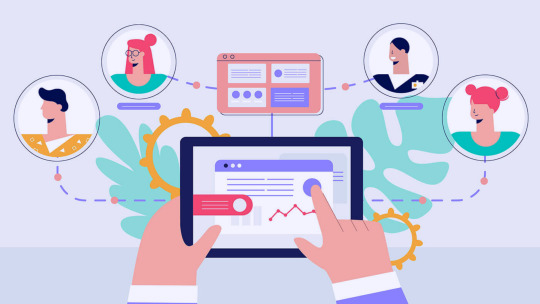
In addition to time-tracking software, businesses can use remote workforce management software to streamline their remote work processes. These tools offer features such as inside threat prevention, employee scheduling, performance monitoring, and collaboration tools. By using these tools, businesses can ensure that their remote workforce remains productive and accountable.
Maintaining Communication and Trust
One of the key aspects of effective time tracking for remote employees is maintaining open communication and building trust. Managers should regularly check in with remote employees to discuss their progress, address any concerns, and provide feedback. It helps build a sense of accountability and ensures that employees feel supported in their work.
Another significant factor is trust. Trusting remote employees to manage their time effectively is crucial for maintaining a positive work environment. By demonstrating trust in their employees, managers can foster a sense of responsibility and encourage employees to take ownership of their work.
Implementing Flexible Work Policies
To further support remote employees, businesses can implement flexible work policies. These policies allow employees to work at times that are most convenient for them, which can help improve work-life balance and reduce stress. Flexible work policies can also help employees manage their time more effectively, leading to increased productivity.
Utilizing Performance Metrics
In addition to time tracking, businesses can use performance metrics to evaluate the effectiveness of their remote workforce. Metrics such as project completion rates, customer satisfaction scores, and employee feedback can provide valuable insights into the performance of remote employees. By analyzing these metrics, businesses can identify areas for improvement and make data-driven decisions to enhance productivity.
Encouraging Work-Life Balance

Promoting work-life balance is essential for remote employees to avoid burnout and maintain productivity. Encourage employees to establish boundaries between work and personal life by setting specific work hours and taking regular breaks. Providing resources for mental health support can also help employees manage stress and stay motivated.
Training and Development Opportunities
Investing in training and development opportunities for remote employees can improve their skills and productivity with keystroke logging. Offer online courses, workshops, and seminars that are relevant to their roles and career goals. By investing in their professional development, employees are more likely to stay engaged and committed to their work.
Regular Performance Reviews
Conducting regular performance reviews is crucial for tracking remote employees' progress and providing constructive feedback. Use these reviews to discuss goals, address any performance issues, and recognize achievements. It helps employees stay motivated and ensures that they are meeting expectations.
Conclusion
Managing remote employee time tracking challenges requires a combination of effective tools and strategies. By using time-tracking software, setting clear expectations, and utilizing remote workforce management software, businesses can overcome the challenges of tracking remote employees' time and ensure that their remote workforce remains productive and accountable.
#Remote employee time tracking#Tracking remote workers#Remote workers time tracking#time Tracking for remote workers#Time tracking for remote employees
0 notes
Text

Software developer productivity tools are designed to enhance efficiency, streamline workflows, and eliminate distractions for developers. These tools focus on coding, collaboration, task management, and automation to help developers deliver high-quality software faster.
0 notes
Text
How Time and Attendance Systems Boost Employee Productivity
In today’s fast-paced business environment, managing time effectively is critical for both employees and employers. Time and attendance systems have evolved from simple punch cards to sophisticated digital solutions, offering a range of benefits that go beyond tracking work hours. Here’s how these systems play a crucial role in enhancing employee productivity.
1. Eliminating Manual Errors
Traditional timekeeping methods, such as manual logs or spreadsheets, are prone to human errors. Mistakes in recording work hours can lead to disputes, payroll inaccuracies, and wasted time resolving issues. Modern time and attendance systems automate these processes, ensuring accuracy and reducing administrative burdens, allowing employees to focus on their core tasks.
2. Streamlining Administrative Tasks
Automated time and attendance systems significantly reduce the time HR and managers spend on administrative duties. Tasks like tracking overtime, managing leave requests, and calculating payroll are streamlined, freeing up time for strategic initiatives and employee engagement efforts.
3. Enhancing Accountability
With precise time tracking, employees become more accountable for their schedules. Knowing that their attendance and work hours are being accurately monitored fosters discipline and reduces instances of tardiness or early departures.
4. Supporting Flexible Work Arrangements
Time and attendance systems often include features like remote clock-ins and mobile apps. This flexibility allows businesses to support remote work, hybrid models, and shift work efficiently. Employees can log their hours from anywhere, ensuring that productivity isn’t compromised by location.
5. Providing Real-Time Insights
Advanced systems offer analytics and reporting features, enabling managers to monitor workforce trends, identify bottlenecks, and optimize schedules. For example, tracking peak productivity hours or detecting patterns of absenteeism can help businesses make informed decisions to improve workflow.
6. Improving Employee Morale
When employees see that their hours are accurately tracked and reflected in timely, error-free payroll, it builds trust and satisfaction. Features like self-service portals also empower employees to check their attendance records, apply for leave, or view their schedules, fostering transparency and reducing confusion.
7. Encouraging Better Time Management
Time and attendance systems often include reminders and notifications for clock-ins, breaks, and deadlines. These prompts encourage employees to manage their time effectively and stay on task, contributing to higher productivity levels.
8. Ensuring Compliance
For businesses, staying compliant with labor laws and overtime regulations is essential. Time and attendance systems automatically calculate work hours and flag potential compliance issues, reducing the risk of legal complications. This allows employees to work confidently within the framework of labor laws.
9. Reducing Time Theft
Features like biometric clock-ins or geolocation tracking prevent practices such as buddy punching or unauthorized overtime. By minimizing time theft, businesses can save costs and allocate resources more effectively.
10. Optimizing Workforce Planning
With accurate data on employee availability and work hours, managers can create efficient schedules that balance workload distribution and avoid overburdening team members. This not only boosts productivity but also prevents burnout.
Conclusion
Time and attendance systems are more than just tools for tracking hours—they’re a powerful resource for enhancing productivity, improving workforce management, and building a transparent workplace culture. By adopting modern systems, businesses can save time, reduce errors, and empower employees to perform at their best.
More info: https://ahalts.com/solutions/hr-services/outsourcing-time-attendance
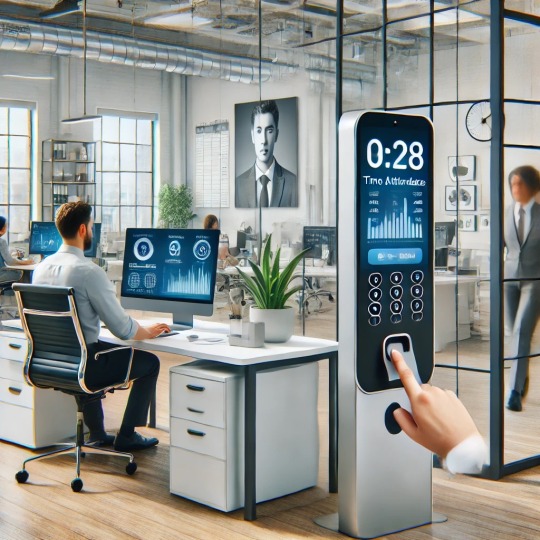
#Time and attendance systems#Employee productivity#Workforce management#Attendance tracking#Time tracking software#Employee accountability#Digital timekeeping#Workplace efficiency#Remote work tracking#Biometric attendance systems#HR technology
0 notes
Text

Time Tracking Software for Remote Employees. Visit: https://buddypunch.com/blog/time-tracking-software-remote-workers/
0 notes
Text
Boost Team Efficiency with ONEMONITAR
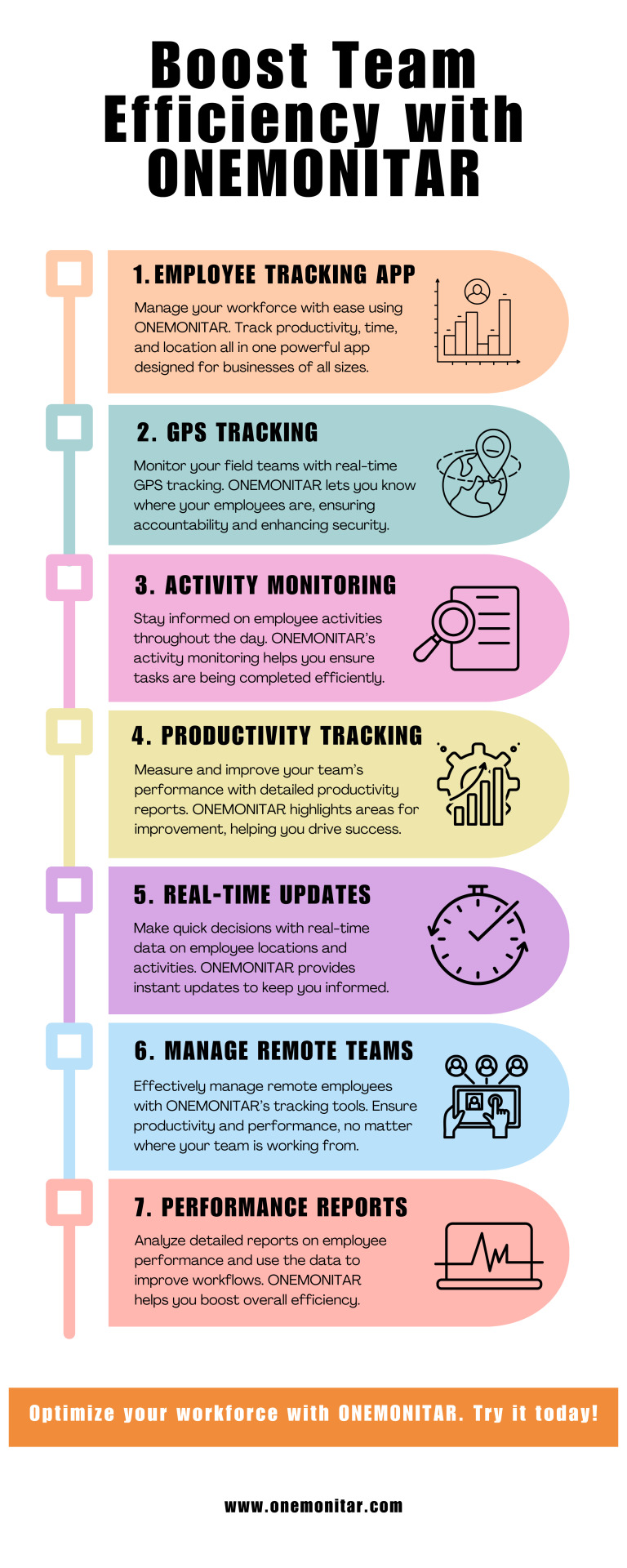
Looking for an efficient way to manage your team and boost productivity? Check out ONEMONITAR's employee tracking app infographic! Discover how you can easily track employee activities, monitor GPS locations, and get real-time updates—all from one app. Whether you're managing a remote team or need detailed performance reports, ONEMONITAR helps you stay on top of your workforce and improve results.
Boost your business performance today with ONEMONITAR!
#Best employee tracking app#Employee monitoring software#GPS employee tracking app#Employee activity monitoring app#Employee productivity tracking app#Employee tracking app for Android#Remote employee tracking app#Real-time employee tracking app#Employee location tracking app#Employee tracking software for small business#Employee performance tracking app#Mobile employee tracking app
0 notes
Text
The Positive Impact of Flowace Employee Monitoring Software

Employee monitoring software often comes with negative connotations, such as micromanagement and lack of trust. However, when used effectively, it can be a powerful tool for enhancing workplace culture and boosting employee engagement. Flowace Employee Monitoring Software stands out as a prime example of how monitoring tools can positively transform the workplace. Here’s how Flowace can help create a supportive, engaging, and productive work environment:
Foster Transparency and Trust
Flowace Employee Productivity Monitoring Software can promote transparency and trust by tracking and reporting on employee productivity. When employees understand that their activities are being monitored to improve productivity and identify areas for growth, they are more likely to feel valued and supported. This transparency fosters an open environment where employees are aware of expectations and outcomes.
Encourage Goal-Setting and Progress Tracking
Flowace makes goal-setting and progress tracking straightforward. By setting clear objectives and regularly monitoring progress, employees remain motivated and engaged. This feature not only helps employees stay on track but also allows managers to identify areas where employees may need additional support or training, ensuring everyone is aligned with the company's goals.
Provide Personalized Feedback and Coaching
Flowace provides detailed data on employee performance, enabling managers to offer personalized feedback and coaching. Specific, actionable feedback helps employees make meaningful improvements and feel supported in their professional development. Personalized coaching based on real data can lead to significant enhancements in performance and job satisfaction.
Cultivate Accountability and Ownership
With Flowace, employees know their work is being monitored, which encourages them to take ownership of their tasks and responsibilities. The software tracks progress and identifies areas for improvement, helping employees feel accountable for their work and proud of their accomplishments. This sense of ownership can lead to a more engaged and motivated workforce.
Use Data for Informed Decisions
Flowace provides valuable insights into employee productivity and work habits. Managers can use this data to make informed decisions about workflow, training, and resource allocation. By relying on data to drive decisions, companies can create a more efficient and effective work environment, optimizing resources and processes for better outcomes.
Celebrate Successes and Achievements
One of the most impactful features of Flowace is its ability to highlight and celebrate successes and achievements. By tracking progress towards goals and providing regular feedback, managers can easily recognize when employees make significant improvements. Celebrating these milestones boosts morale and fosters a positive work culture, encouraging employees to continue striving for excellence.
Conclusion
Flowace Employee Monitoring Software is more than just a tool for tracking productivity; it’s a catalyst for creating a positive work environment. By fostering transparency and trust, encouraging goal-setting and progress tracking, providing personalized feedback and coaching, cultivating accountability and ownership, using data for informed decisions, and celebrating successes, Flowace helps companies build a supportive, engaging, and productive workplace. When implemented transparently and ethically, Flowace can become an invaluable asset, transforming workplace culture and enhancing employee engagement.
0 notes
Text
How Can Employee Productivity Tracker Streamline Project Management?
In today's dynamic work environment, where deadlines loom and resources are often stretched thin, managing diverse projects with remote employees is one of the biggest challenges for managers. However, a centralized employee productivity tracker can be your trusted ally to monitor how your employees utilize their time and resources. Since this tool provides insightful data in real-time, organizations can seamlessly navigate through the complexities with greater clarity regarding project progress.
Imagine a situation wherein every activity of your employee is visible remotely and a dashboard that paints a clear picture of the team’s performance, hidden insights into workflow, and overall business strategies. Sounds too good to be true, right? An employee tracking solution frees managers from guesswork as it offers accurate insights into the productivity levels of every team member, time taken to complete tasks, and employee performance. Also, it aids in identifying bottlenecks in the workflows.
In this blog, we will highlight practical ways to manage diverse projects with remote employees by utilizing robust features of employee time-tracking apps for your better understanding.
What is Employee Tracking Software?
Monitoring the productivity of your remote employees can be difficult when done manually through calls or emails. With the rising shift towards remote work environments, managers are finding it difficult to enhance work efficiency, drive scalability, and achieve overall business success. Hence, it is imperative for businesses to adapt innovative tools to manage remote teams and enhance productivity.
In addition, TrackOlap employee monitoring software provides insightful data on several parameters in real-time, supporting businesses in making informed decisions and continuously enhancing workflows and other improvements. As a manager, you can observe employees' behavior during working hours, identify areas for improvement in team performance, and ensure the overall business operation thrives.
Lastly, by tracking employees' activities and work efficiency through a central dashboard, managers can save time from constantly following up with employees and maximize ROI.
What Metrics Does Employee Productivity Tracker Record?
As mentioned above, an employee productivity tracker enables businesses to track team activities, productivity levels, and more. This enables managers to consistently track progress over varied projects, identify inaccuracies in real-time, and make adjustments promptly to avoid delayed submissions or interrupted workflows. Let us explore a range of metrics that this software offers to multiple businesses.
Time Utilized: Average time spent on per task or project. Remote work management software offers a seamless data breakdown of where your resources spend time.
Employee’s Idle Time: An employee time tracking app captures the total number of breaks or duration of time off amid working hours to help managers identify unproductive team members
Computer Activity: Tracks website, documents, and applications visited by employees during working hours to determine their active time
Completed Tasks: Based on the overall output delivery, employee tracking solution keeps a record on overall completed tasks to optimize resource allocation strategy for the team
Moreover, employee time-tracking app tends to answer a range of questions with added clarity:
At what time does the team log-in and log-out?
Who are the underperformers and top performers in the team?
What sites is the team viewing, and for how much time?
What resources do we need to acquire project objectives?
Where do we need to focus on to drive better revenue?
You May Also Like: How can Remote Work Management Software Enhance Business Operations?
Why is there a sudden drop in the remote team’s performance?
The metrics of remote work management software collectively offer visibility to the managers for time management and overall productivity of the team to consistently improve business operations, workflows and other aspects hassle-free.
Top Reason Why You Need Employee Productivity Tracker
Maintaining productivity is important for every business irrespective of what you do, and what you offer. It can become a complex process if you work with a remote team. Hence, implementing a robust employee productivity tracker is extremely important in today’s fast-paced world. Let us explore a few benefits of this software.
1. Effective Project Management
Managers can effortlessly manage project schedules and essential assignments through a centralized employee time-tracking app. By accessing historical data on parameters like employee performance, caliber, productivity levels, and more - as a manager, you can schedule tasks or allocate assignments based on the timeframe.
By constantly tracking their activities, you can immediately capture inaccuracies and find alternative solutions without interrupting the project's scheduled workflow.
2. Strategic Resource Allocation
Consistently monitoring employees’ productivity levels through remote work management software aids in identifying areas of h igh and low efficiency in the team. This data will support you with planning strategic resource allocation and ensure equal workload distribution.
In addition, centralized dashboards are an additional benefit for managers to access an overview of the entire team’s activities. Whether it is project deadlines, allocating assignments according to employees' expertise, staffing level, or overall team workload capability, an employee productivity tracker can come to your rescue.
3. Thorough Performance Analysis
Are you looking to re-align your allocation process? Access productivity levels and overall output delivered by your team members in previous weeks or months to determine their performance. Additionally, through graphically-rich reports, you will have a better picture of the overall team’s progress and encourage them to perform better from these analytics to drive better outcomes.
4. Assess Return on Investment (ROI)
By tracking your team’s productivity levels through employee tracking solutions, you can also analyze the effectiveness of the investment you made in varied tools, resources, and more. Yes, you heard it right! You can evaluate the overall output delivered by your team, their efforts, or work efficiency to understand the profitability of your projects and make better decisions for future endeavors.
5. Evaluate Workload Balance & Employee Burnouts
If your resource allocation strategy isn't optimized, or if you fail to manage equal workload within your team, your employees may feel burnout very frequently, which can ultimately affect their well-being.
However, many factors can lead to employee burnout, such as an imbalance in workload for a longer period of time. When you track productivity levels, if you observe uneven results, such as high-performers being unproductive or a sudden drop in overall output delivery, then it is an indication that they are on the edge of experiencing burnout.
Hence, it is important to set a realistic timeline for every delegated task, track achievable targets promptly, and ensure every employee has a suitable workload that is important for achieving project success.
6. Track Goals and Achievements
Tackling your employees' efficiency levels aids in setting realistic goals. Regularly measuring progress for these objectives will keep you aligned with minute progress. Additionally, evaluating reports like productivity vs. targets acquired assists in motivating employees to work closely to achieve specific goals and encourages teams to be accountable for certain aspects.
How to Manage Projects with Employee Tracking Solutions?
TrackOlap provides comprehensive software to manage projects, remote teams, and upscale business profitability with robust features. However, this software goes beyond productivity or time tracking as it offers valuable insights on many parameters that might otherwise go untapped.
1. Tracks Time Autonomously
It is important to understand your objectives before you implement varied strategies. Based on your objectives, consider integrating a time tracker like TrackOlap to foster accountability and transparency into the workflow and avoid interrupting your employees' privacy.
Since this software seamlessly tracks computer usage by activities, visited sites, documents, or apps, it helps managers access the active time of every employee. This can be helpful for organizations that have team members from different time zones. Moreover, these features remove the process of back-and-forth follow-ups, manual log-ins, and updating progress on every task.
2. Setting Productivity Benchmarks
Employee tracking solutions simplify the process of identifying when employees are productive and when they trick the team with time theft. This can help managers address such concerns in real-time and collaborate with employees in 1:1 sessions to boost business growth.
By encouraging employees to perform better and focusing on activities for employee development, you are likely to set high benchmarks for employee productivity. This approach will encourage team members to perform better and be focused, especially when their efforts are acknowledged and appreciated with a certain level of recognition. Ultimately, all these aspects will lead to better revenue, satisfied clients, and retained employees.
3. Effective Project Budgeting
Managers can conduct a thorough project cost analysis through data-driven reports based on the employee's performance, productivity levels, and amount of output delivered in previous months. Based on this analysis, businesses can estimate an average feasible timeline to complete a project without causing burnout among team members and an overall budget to ensure you achieve significant profitability with your existing team.
4. Customized Reporting and Analysis
Whether you want to determine the effectiveness of your resource allocation strategy, workflow efficiency, productivity levels, employee accountability, or team performance - TrackOlap simplifies the evaluation process by offering a robust feature for creating customizable reports based on specific parameters.
Moreover, a centralized dashboard offers an overview and statistics that give the organizations a clear picture of varied aspects and departments, supporting consistently making informed decisions hassle-free.
Final Thoughts
In today’s dynamic environment, an employee productivity tracker is valuable for businesses. It not only enhances productivity levels but also offers accurate data on work output and the effectiveness of varied strategies with clear visibility. Moreover, managers can easily manage teams and projects without micromanaging daily, thanks to features like idle time tracking, customized reports, and more metrics.
Transform your business profitability and change how you manage projects by adopting a time-tracking tool into your system. Contact us to get a quick demo of these features today!
#employee time tracking software#Lead automation app#Employee Productivity Tracker#employee time tracking app#system idle time tracking software#employee monitoring software#employee time tracker#remote work management software#remote team management software
0 notes
Text
Boost Productivity & Transparency: Top Remote Employee Time Tracking Tools
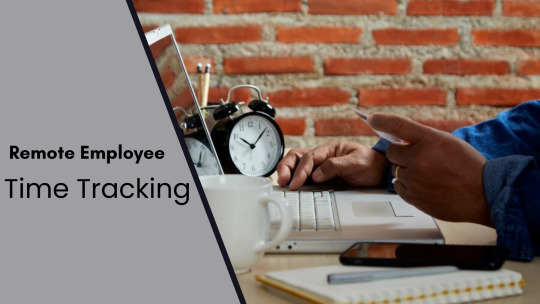
As remote work becomes increasingly common, especially in light of recent global events, businesses need efficient methods to track employee productivity and ensure accurate payroll processing. Remote time tracking involves various tools and techniques designed to monitor employee work hours, track tasks and projects, and maintain transparency and accountability in remote work arrangements.
One of the primary methods of remote employee time tracking is through the use of time tracking software and applications. These tools allow employees to log their work hours, record time spent on specific tasks or projects, and track breaks and non-productive activities.
Managers can access these records in real-time to monitor employee productivity, identify bottlenecks, and provide feedback or support as needed. Additionally, time tracking software often integrates with project management tools, enabling seamless coordination and collaboration among remote teams.
Another common approach to tracking remote workers tool is through the use of biometric or digital time clocks. These devices, which may include fingerprint scanners or facial recognition technology, allow employees to clock in and out remotely, providing an accurate record of their work hours. This method helps prevent time theft and ensures that employees are paid fairly for the time they work.
Tips Or Tricks For Optimizing Remote Time Tracking Efficiency
Set Clear Goals And Priorities: Start your day by outlining specific goals and priorities. Break down larger projects into smaller, actionable tasks. Prioritize tasks based on deadlines, importance, and impact. Tools like time tracking for remote workers or project management software can help you organize and prioritize your workload effectively.
Use Time Tracking Tools: Explore various remote workers time tracking options available to find one that best suits your needs. Look for features such as automatic time tracking, customizable project tracking, and integration with other productivity tools. Experiment with different tools to find the one that fits seamlessly into your workflow. Establish A Routine: Create a daily routine that aligns with your natural energy levels and peak productivity times. Designate specific work hours and stick to them consistently. Incorporate regular breaks to avoid burnout and maintain focus throughout the day.

Minimize Distractions: Identify common distractions in your work environment and take steps to minimize them. This may involve setting boundaries with family members or roommates, using website blockers to limit access to distracting sites, or designating a dedicated workspace free from distractions.
Time Blocking: Allocate dedicated time blocks for different tasks or projects throughout your day. Use tools like calendars or planners to schedule time for focused work, meetings, breaks, and personal activities. Be realistic about the time needed for each task and adjust your schedule as needed.
Top 3 Remote Worker Time Tracker
Toggl
Toggl is a popular time tracking for remote employees known for its simplicity and user-friendly interface. It offers features like one-click timers, customizable project tracking, and detailed reporting. Toggl also integrates with various project management and productivity tools, making it easy to track time across different tasks and projects. It's suitable for freelancers, remote workers, and teams of all sizes.
EmpMonitor
The EmpMonitor is a comprehensive employee monitoring and time tracking software designed for remote teams. In addition to tracking time spent on tasks and projects, EmpMonitor offers advanced features such as keystroke logging, website and application tracking, screenshot capture, and activity monitoring.
It provides detailed insights into employee productivity, allowing managers to identify inefficiencies, optimize workflows, and ensure compliance with company policies. EmpMonitor is suitable for businesses that require advanced monitoring and time tracking capabilities for remote teams.
Clockify
Clockify is a free remote workforce management software with robust features for remote workers and teams. It offers unlimited users and projects, allowing you to track time spent on tasks, projects, and clients. Clockify offers browser extensions, desktop apps, and mobile apps for seamless time tracking across devices. It also provides detailed reports and insights to analyze productivity and billable hours. Also Watch: Leading Employee Engagement and Workforce Productivity Tool
youtube
Epilogue!
In conclusion, remote employee time tracking stands as a pivotal aspect of modern work dynamics, especially in the context of the increasingly prevalent remote work environment. As organizations transition to distributed workforces, the need for efficient and accurate methods of monitoring employee productivity and managing work hours becomes ever more crucial.
Through the utilization of advanced time tracking tools and techniques, businesses can effectively navigate the challenges of remote work and ensure optimal performance and accountability among their remote employees.
1 note
·
View note
Text
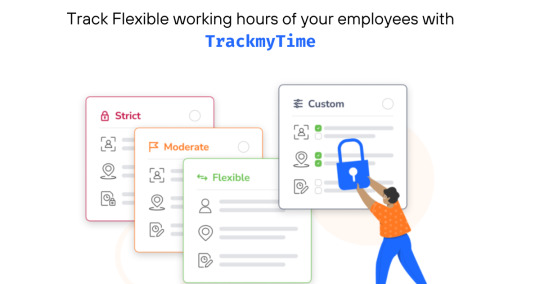
⌚ A flextime employee may become lazy and misuse the flextime policy. With a flexible work schedule, you may not be able to supervise employees who work during non-traditional work hours.
For example, if you start working at 9 AM and an employee starts working at noon, you may not be able to monitor them after you leave the office.
Employees misuse flextime by leaving early or browsing social media during work hours. This can lead to a lack of productivity, lower morale, and a decrease in work quality.
⚠️ During a work-from-home situation, what steps can you take to avoid this kind of scenario?😯
Fortunately, you can supervise such employees using TrackmyTime.
TrackmyTime simplifies the monitoring and time tracking for employees.
TrackmyTime keeps track of and records your remote employee activities during working hours, no matter where they are located.
It can analyze productivity to see how your team's time is spent and automatically record time entries for hours worked on timesheets.
It can also notify you of any suspicious activity, such as extended breaks or working late or idle. This will keep your employees focused on tasks and working efficiently.
That's not at all! You can view the other interesting features here: Employee Flexi Time Tracking App
#time tracking#employee productivity#employee monitoring software#remote work#remote employee monitoring
0 notes
Text
Take Charge Of Your Finances: Track Billable Hours With Ease
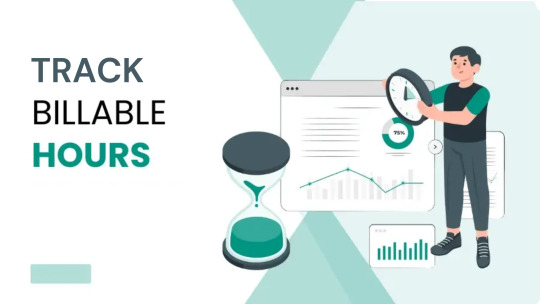
Modern business requires a close eye on finances due to its dynamic nature. One key aspect of financial management, especially for service-based businesses, is tracking billable hours. This practice not only ensures accurate client billing but also provides valuable insights into employee productivity and project efficiency. Fortunately, with the right tools and strategies, mastering to track billable hours can be both straightforward and efficient.
Understanding the Importance of Billable Hours Tracking:
Before delving into the how-to aspect, it's crucial to understand why tracking billable hours is so essential. Essentially, billable hours represent the time spent by employees on tasks or projects that can be billed to clients. By accurately tracking these hours, businesses can ensure they are billing clients correctly, leading to improved cash flow and profitability.
Moreover, billable hours tracking offers insights into employee productivity and project performance. It enables businesses to identify inefficiencies, allocate resources effectively, and optimize workflows for better outcomes. Additionally, it serves as a valuable tool for evaluating project profitability and making informed decisions about resource allocation and pricing strategies.
Choosing the Right Tracking Tool:

With the advancement of technology, numerous tools and software solutions are available to streamline billable hours tracking. When selecting a tool, consider factors such as ease of use, compatibility with existing systems, features offered, and scalability. Look for a solution that offers robust time-tracking capabilities, customizable reporting options, and integration with accounting software for seamless invoicing.
Some popular options include dedicated billable hours tracking software, employee productivity trackers, and employee user activity monitoring software. These tools not only automate the tracking process but also provide valuable insights into employee behavior, work patterns, and project progress.
Implementing Effective Tracking Practices
Once you've chosen a suitable tracking tool, it's essential to establish clear guidelines and best practices for your team. Communicate the importance of accurate time tracking and provide training on how to use the chosen software effectively. Encourage employees to track their time diligently and consistently, emphasizing the impact it has on client billing and overall business performance.
Consider implementing remote employee time-tracking solutions, especially in today's increasingly remote work environment. These tools enable businesses to monitor employee activity and tracking billable hours accurately, regardless of their location. However, it's crucial to balance the benefits of remote monitoring with respect for employee privacy and autonomy.
Furthermore, leverage the data collected from billable hours tracking to optimize resource allocation, identify bottlenecks, and improve project management processes. Regularly review reports and analyze trends to identify areas for improvement and implement proactive measures to enhance efficiency and profitability.
Maximizing the Benefits of Billable Hours Tracking:

Beyond its immediate benefits for client billing and project management, billable hours tracking can have long-term implications for business success. By fostering a culture of accountability and transparency, businesses can improve employee satisfaction and retention. When employees understand how their time contributes to the bottom line, they are more motivated to work efficiently and effectively.
Additionally, accurate time tracking provides businesses with valuable data for making strategic decisions and planning for future growth. Whether it's identifying opportunities for service expansion, optimizing pricing structures, or forecasting resource needs, the insights gained from billable hours tracking can inform critical business strategies.
Expanding on the benefits of employee time tracking software, businesses can gain deeper insights into employee productivity and performance. These tools offer features such as activity tracking, screen monitoring, and app usage analysis, providing managers with a comprehensive view of how time is spent during work hours. By identifying inefficiencies and areas for improvement, businesses can optimize workflows, enhance team collaboration, and drive productivity.
Furthermore, employee monitoring software can help ensure compliance with company policies and regulatory requirements. By monitoring unauthorized activities and potential security threats, businesses can mitigate risks and protect sensitive information. Overall, leveraging employee monitoring software as part of a comprehensive billable hours tracking strategy can lead to improved operational efficiency and better business outcomes.
Conclusion
Mastering billable hours tracking is essential for maintaining financial control and driving business success. By leveraging the right tools and implementing effective tracking practices, businesses can streamline operations, improve client satisfaction, and maximize profitability. Moreover, embracing a data-driven approach to time tracking enables businesses to make informed decisions, optimize resource allocation, and stay ahead in today's competitive marketplace. So, take charge of your finances and empower your business with robust-to-track billable hours practices.
#Track Billable Hours#Billable Hours Tracker#Software to Track Billable Hours#Remote Employee Time Tracking#Employee Productivity Tracker
0 notes
Text
Take Charge Of Your Finances: Track Billable Hours With Ease
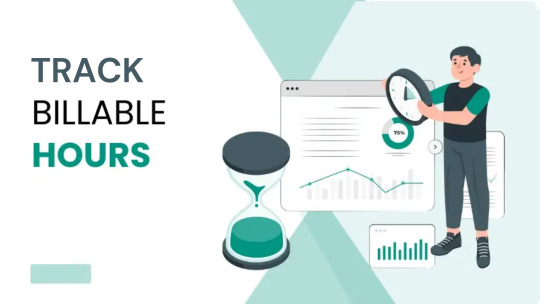
Modern business requires a close eye on finances due to its dynamic nature. One key aspect of financial management, especially for service-based businesses, is tracking billable hours. This practice not only ensures accurate client billing but also provides valuable insights into employee productivity and project efficiency. Fortunately, with the right tools and strategies, mastering to track billable hours can be both straightforward and efficient.
Understanding the Importance of Billable Hours Tracking:
Before delving into the how-to aspect, it's crucial to understand why tracking billable hours is so essential. Essentially, billable hours represent the time spent by employees on tasks or projects that can be billed to clients. By accurately tracking these hours, businesses can ensure they are billing clients correctly, leading to improved cash flow and profitability.
Moreover, billable hours tracking offers insights into employee productivity and project performance. It enables businesses to identify inefficiencies, allocate resources effectively, and optimize workflows for better outcomes. Additionally, it serves as a valuable tool for evaluating project profitability and making informed decisions about resource allocation and pricing strategies.
Choosing the Right Tracking Tool:

With the advancement of technology, numerous tools and software solutions are available to streamline billable hours tracking. When selecting a tool, consider factors such as ease of use, compatibility with existing systems, features offered, and scalability. Look for a solution that offers robust time-tracking capabilities, customizable reporting options, and integration with accounting software for seamless invoicing.
Some popular options include dedicated billable hours tracking software, employee productivity trackers, and employee user activity monitoring software. These tools not only automate the tracking process but also provide valuable insights into employee behavior, work patterns, and project progress.
Implementing Effective Tracking Practices
Once you've chosen a suitable tracking tool, it's essential to establish clear guidelines and best practices for your team. Communicate the importance of accurate time tracking and provide training on how to use the chosen software effectively. Encourage employees to track their time diligently and consistently, emphasizing the impact it has on client billing and overall business performance.
Consider implementing remote employee time-tracking solutions, especially in today's increasingly remote work environment. These tools enable businesses to monitor employee activity and tracking billable hours accurately, regardless of their location. However, it's crucial to balance the benefits of remote monitoring with respect for employee privacy and autonomy.
Furthermore, leverage the data collected from billable hours tracking to optimize resource allocation, identify bottlenecks, and improve project management processes. Regularly review reports and analyze trends to identify areas for improvement and implement proactive measures to enhance efficiency and profitability.
Maximizing the Benefits of Billable Hours Tracking:

Beyond its immediate benefits for client billing and project management, billable hours tracking can have long-term implications for business success. By fostering a culture of accountability and transparency, businesses can improve employee satisfaction and retention. When employees understand how their time contributes to the bottom line, they are more motivated to work efficiently and effectively.
Additionally, accurate time tracking provides businesses with valuable data for making strategic decisions and planning for future growth. Whether it's identifying opportunities for service expansion, optimizing pricing structures, or forecasting resource needs, the insights gained from billable hours tracking can inform critical business strategies.
Expanding on the benefits of employee time tracking software, businesses can gain deeper insights into employee productivity and performance. These tools offer features such as activity tracking, screen monitoring, and app usage analysis, providing managers with a comprehensive view of how time is spent during work hours. By identifying inefficiencies and areas for improvement, businesses can optimize workflows, enhance team collaboration, and drive productivity.
Furthermore, employee monitoring software can help ensure compliance with company policies and regulatory requirements. By monitoring unauthorized activities and potential security threats, businesses can mitigate risks and protect sensitive information. Overall, leveraging employee monitoring software as part of a comprehensive billable hours tracking strategy can lead to improved operational efficiency and better business outcomes.
Conclusion
Mastering billable hours tracking is essential for maintaining financial control and driving business success. By leveraging the right tools and implementing effective tracking practices, businesses can streamline operations, improve client satisfaction, and maximize profitability. Moreover, embracing a data-driven approach to time tracking enables businesses to make informed decisions, optimize resource allocation, and stay ahead in today's competitive marketplace. So, take charge of your finances and empower your business with robust-to-track billable hours practices.
#Track Billable Hours#Billable Hours Tracker#Software to Track Billable Hours#Remote Employee Time Tracking#Employee Productivity Tracker
0 notes
Text
Best Ways to Introduce Productivity Monitoring to an Organization
How to introduce productivity monitoring to your organization?
In any organization, large or small, public or private, there are always opportunities to increase productivity. Another alternative is to keep track of the productivity of your employees. You can do this in various ways, but it is essential to do it in a way that is respectful of employees' privacy and does not create a hostile work environment. Let us learn about it in detail.
What is productivity monitoring software?
Productivity monitoring software is a type of software that helps manage employees' workflow. It also helps ensure that employees are not wasting too much time on social media or other activities that do not contribute to their productivity.
One can use the productivity monitoring tool in various ways depending on the company and its work culture. For instance, some companies use it to ensure that all their employees are working at least 40 hours a week, while others use it to monitor employees' time on social media or online shopping.

Tips on how to introduce productivity monitoring to your organization
To ensure that your organization runs as efficiently as possible, you may consider introducing productivity monitoring. You can discover areas where improvements can be made by charting employee productivity.
To ensure you don't encounter any issues when implementing such a system, consider these things:
1. Be Transparent to your Employees
Employee monitoring is a controversial topic. Some people think monitoring employees is unethical, while others believe it's necessary to maintain productivity. To be transparent and make sure that the employees are happy, employers should have a set of clear rules on how they monitor their employees.
Employers should also be okay with their employees about what they are tracking and why they are doing it.
2. Communication: Update your employees and managers
In a globalized and digitalized world, keeping employees updated with the latest information is necessary. Using different approaches to update employees, such as remote meetings, video conferences, or even online training, is essential. Communication is a vital component of your workplace. Quality-minded when it comes to how you communicate is just as important as what you actually say.
3. Encourage Ownership: Share the data to improve productivity
Employee monitoring is a process of tracking and recording employee's activities and helps managers analyze, evaluate and improve the performance of their employees. Employers can monitor their employee's productivity with a remote environment, flexible implementation, and tracking. The goal is to inform employees about what they are doing wrong and how to improve their performance.
Employers can use this data to find out which team members are more productive than others. They can also see which tasks require more effort from the employee's side and should be prioritized accordingly.
4. Ensure Remote culture
Remote work culture is a relatively new concept, and it's one that many people are wary of. It helps to increase employee productivity and reduce absenteeism. To keep track of employees, companies use different tools that monitor their activity and location. The most popular tool is software that tracks employees' office hours, remote work hours, and breaks taken.
Having a remote culture in an organization is crucial so that employees feel comfortable with the environment they are working in. It is vital to have a remote culture in an organization so that employees feel comfortable with the environment they are working in.
5. Recognize Privacy Concerns
With the prevalence of remote workers, flexible schedules, and remote settings, it's now more challenging to know what your employees are doing at home or at work. This can lead to many privacy concerns. There are many ways to implement employee tracking and monitoring, but choosing one that suits your needs best is essential.
Observing your employees will help you keep track of their performance and ensure they are engaged in work in accordance with your expectations. The program will help you determine if any suspicious activity or actions are taking place over a remote distance.
Ending Up the blog:
To conclude, it is essential to consider all the potential risks and benefits of introducing productivity monitoring to your organization. Both efficient manual and automated forms of productivity tracking exist. As you decide if you'd like to implement productivity monitoring, it's a good idea to choose an approach that is respectful of your workers' privacy.
You can use the Time Champ software to make it more effective among employees. The Time Champ tool is an ideal way to keep track of employee productivity and identify areas where improvements are made. Implementing a productivity monitoring system can help your organization reach its full potential.
0 notes
Text
Software Development Team Productivity
Productivity tools are designed to enhance efficiency, streamline workflows, and eliminate distractions for developers. Software developer productivity tools focus on coding, collaboration, task management, and automation to help developers deliver high-quality software faster.

#remote work tracking software#desktop monitoring software#employee time tracking software#time tracking software
0 notes
Text
Mobile Time Attendance Applications
Mobile time attendance applications offer flexibility and convenience for businesses and employees, especially in remote work settings. These apps allow employees to clock in and out from their smartphones, ensuring accurate time tracking from any location. Features like GPS tracking verify the location of remote workers, while real-time synchronization provides managers with instant access to attendance data. The use of mobile apps streamlines the attendance process, reduces the need for physical systems, and allows for greater flexibility in managing a dispersed workforce. Mobile time attendance apps also improve accuracy and accountability, as they often integrate with payroll systems for automatic wage calculation.
More info: https://ahalts.com/solutions/hr-services/outsourcing-time-attendance

#mobile time attendance apps#remote employee attendance tracking#GPS time tracking#mobile time tracking#real-time attendance app#smartphone attendance solutions
0 notes
Text
GPS Employee Tracking App - ONEMONITAR
Monitor your team's location in real time with ONEMONITAR’s GPS employee tracking app. Perfect for field teams, this app ensures you always know where your employees are, improving security and productivity.
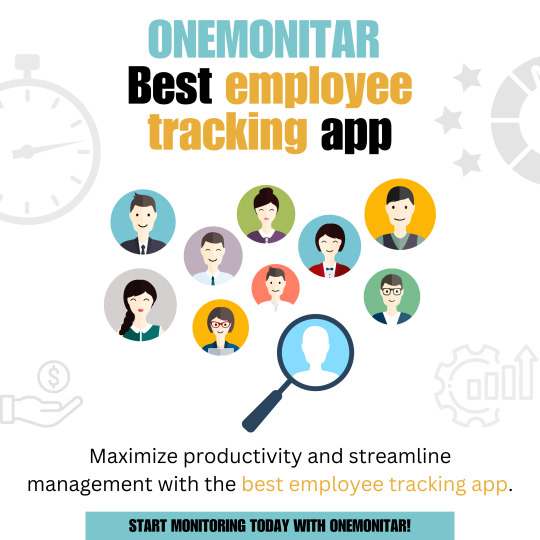
#GPS employee tracking app#Employee activity monitoring app#Employee productivity tracking app#Employee tracking app for Android#Remote employee tracking app#Real-time employee tracking app#Employee location tracking app#Employee tracking software for small business#Employee performance tracking app#Mobile employee tracking app#Best employee tracking app#Employee monitoring software
0 notes